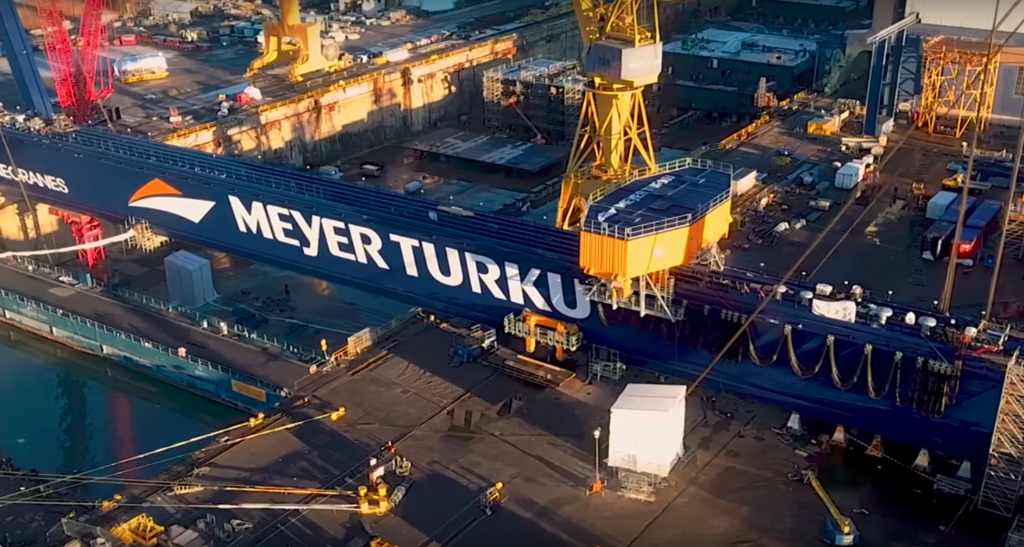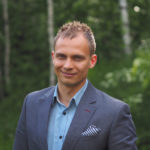14.2.2018 - Johannes Puro - Lighting

The monumental Goliath gantry crane of Meyer Turku shipyard rises to 120 meters making it now the tallest crane in the Nordic countries. The crane has a total lifting capacity of 1,200 tons but the real giant is the 2500 ton main beam, the raising of which took two whole days and got a lot of media attention in November 2017.
The new crane is expected to increase output capacity and help Meyer Turku reach higher production levels. However, the Goliath is not just an important investment on the maritime industry of Finland but a state of the art instrument introducing game-changing technologies.
To enable best possible working conditions, the crane is equipped with an advanced LED solution manufactured by Easy LED Ltd, expert on creating energy efficient LED lighting for sport arenas, streets and urban areas as well as demanding industrial sites.
– The Goliath was a project worthy of its name, requiring aligned communication in planning with Meyer Shipyard, the crane supplier Konecranes and their design subcontractor, tells Ilkka Kartio, the Managing Director of Easy LED.

Heikki Kasurinen (on the left) and Ilkka Kartio standing beside EasyLED’s own BUBO luminaire.
The Goliath has many custom features designed to meet its high requirements. According to Kartio, the brackets of the luminaires were tailor made to fit the crane and the dimming control had to be specially designed to comply with the other control systems in the crane. The possibility to dim luminaires contributes to achieve circa 40-50% less energy consumption.
– In general, LED gives better quality light compared to the traditional high pressure sodium lamps which, for instance, do not recreate colours, tells Heikki Kasurinen, the Director of International Sales.
– With our system it is possible to get 50 % more light with the same installation power, he explains.
According to the men, it is important that the light is uniform also above the ground so that the lifted objects and higher decks of the current ship being built can be seen clearly at all times. This is yet another requirement that makes LEDs rational choice as they will keep their intensity and colour over time.
With better light installations it is also possible to reduce mistakes and accidents and thereby improve human safety, Kartio and Kasurinen remind.
The lifting of the main beam:
Another recent site for Easy LED is the Port of Turku which has the Easy Led BUBO floodlight network installed in the harbour area. BUBO is an energy-efficient, high power lighting system designed especially for large area illumination.
– What makes BUBO special in the Port of Turku, is that the whole lighting system is radio controlled: All the lights can be switched on and off or dimmed remotely. Also the energy consumption of the lighting masts or possible faulty situations can be monitored on-line as all the data goes directly to a cloud service, tells Kasurinen.
– No need to drive around to check if everything is OK. Now the operations manager can adjust the settings by hand.
The radio control system is provided by C2 Smartlighting Oy and it is integrated to Easy LED’s system throughout the harbour. Lighting can be controlled based on environment or time which allows to dim the lights by daylight or brighten them during traffic peaks at the harbour, for instance.
– The dimming definitely brings savings as energy is consumed only when needed. However, it also creates new opportunities: The lighting can be temporarily adjusted brighter for instance for ships arriving at night. Or in a shipyard the lights can be blinked to alert people in the working area – previously that was made with sound signals.

LED lights keep the harbour area illuminated in the Port of Turku.
One important asset of LED lighting lies in the easy maintenance. LEDs do not need changing every 3 to 5 years like traditional light bulbs – with LEDs one can reach up to 100 000 hours of maintenance free useful life which means about 20 to 30 years of normal usage.
– This really comes into prominence when dealing with constructions like the Goliath or other high cranes and masts. Usually a special lift is needed to reach the luminaires high up which makes the maintenance expensive, Kartio explains.

Thanks to the advanced LED technology, the BUBO luminaires have a lifespan of several decades.
To balance its many practicalities, bright lighting also has its drawbacks such as light pollution or photopollution.
Light pollution is a side effect of industrial civilization, causing energy waste and serious environmental consequences for humans, wildlife, and climate. Excessive light impacts on plant and animal physiology posing a threat especially to nocturnal animals, but it can also cause health problems for humans by confusing our natural circadian rhythm and the production of melatonin.
As habitation and industries spread, the lighting industry has to develop lighting design and introduce smart solutions to reduce potential environmental impacts. Easy LED works actively to offer energy-efficient and environment friendly solutions that follow legislation.
– Besides our advanced LED-luminaires, we can deliver detailed plans and 3D simulations to demonstrate how we control the direction of the light. For example in the Port of Turku we designed the area very carefully to minimize the light escaping to the opposite bank of the river, explains Kartio.
– As we mentioned before, dimming the luminaires when not needed brings savings but it is also a great example on how we can reduce light pollution around the harbour area as less light is reflected from the ground.

The Port of Turku in night lighting.
When it comes to the wellbeing of workers, the consistency and the quality of light matter. The uniform, flicker-free light of LED helps to reduce eye fatigue because one doesn’t have to readjust to different light levels all the time.
– The high quality of the product along with adjustability and easy maintenance are our best selling points. Compared to traditional bulbs, LEDs create better quality light and light colour for so many different applications.
– And of course they produce less waste than bulbs with their package material since LEDs don’t need replacing so often, Kartio closes.
Interviewee
Author

Leave comment - comments(0)